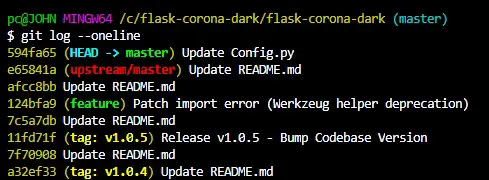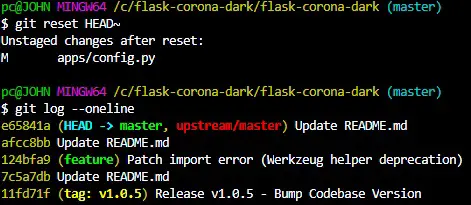Delete commits but keep changes in Git
This article outlines the steps necessary to undo a Git commit while preserving the changes introduced by the same commit. We'll cover two commands we can use that have the same effect.
Without further ado, let’s jump right in.
Remove commits but keep changes in Git
Let's explore this concept with an example.
Assuming we have a commit history in our repo like below, how can we remove the latest commit but keep the changes?

There are two approaches we can take to achieve our goal. Let's look at the first approach, which is the simplest.
Use the git reset command to remove commits and keep changes
We can undo a commit while preserving our changes using the git reset command as follows:
$ git reset HEAD~
This should remove the Update Config.py commit but keep the changes to the file. We can run the git log command to confirm our situation.

If you run the git status command you will see that you have unstaged changes. This does not necessarily mean that your files have changed.
When we use the git reset--soft command without the -p or --hard-p option , Git will undo the specified commit without changing the files affected by the commit.
You can add changes to the index and run git commit --amend--no-editthe command to remove changes from the index and mount them to the latest commit.
Alternatively, instead of deleting a commit, you can continue developing and run the command when you need to make a new commit git commit --amend. At this point, you will add your new modifications to the commit you want to delete, and you can also edit the commit message.
In short, Git allows us to undo a commit and keep the changes introduced by the same commit. We can use git resetthe git undo and git commit --amendgit commands to achieve our goal.
For reprinting, please send an email to 1244347461@qq.com for approval. After obtaining the author's consent, kindly include the source as a link.
Related Articles
Git installation and establishment of local warehouse service
Publish Date:2025/04/05 Views:89 Category:Git
-
Git is a distributed version control system: the client does not only extract the latest version of the file snapshot, but also completely mirrors the original code repository. It has the following advantages: a. Since every extraction oper
git remote operation——multiple remote repositories for one project
Publish Date:2025/04/05 Views:131 Category:Git
-
Multiple remote repositories for a git project In our git project, the command to operate the remote repository information is $ git remote # 查看当前所有的远程仓库的名称 $ git remote -v # 查看远程仓库的名称和远程仓
Git cherry pick command usage
Publish Date:2025/04/05 Views:190 Category:Git
-
git cherry-pick is a powerful command that allows us to select an arbitrary Git commit by reference and attach it to the HEAD of the current working branch. Cherry picking is the act of picking a commit from one branch and applying it to an
Comparison between Git merge and Git rebase
Publish Date:2025/04/05 Views:171 Category:Git
-
The git rebase command may seem like Git wizardry to beginners, but if used carefully, it can actually make life easier for your development team. In this article, we compare git rebase with the related git merge command and identify all th
How to fix Git error Error: src refspec master does not match any
Publish Date:2025/04/05 Views:124 Category:Git
-
When using Git, we may encounter the error "src refspace master does not match any". Here's what the error means and how to fix it. What does src refspec master does not match any Mean in Git mean? We may encounter this error when we try to
Rebase local branch when pulling changes from remote repository branch in Git
Publish Date:2025/04/05 Views:144 Category:Git
-
This article will cover the basics of rebasing your local branch when pulling changes from a remote repository branch in Git. We use the version control system Git to track changes made to files. We commit changes in a local branch in our l
Undo Git Stash
Publish Date:2025/04/04 Views:187 Category:Git
-
This article explains how to make and save changes to a repository. Git allows you to save changes locally and push them to a server when needed. In Git, we don't use the term save , but commit . We use git add , git commit , and git stash
View a list of cache entries in Git
Publish Date:2025/04/04 Views:59 Category:Git
-
We often need to pause our work and focus on something else in our development environment. Therefore, we may need to temporarily save our current work and focus on a different one. We may want to resume our original work later. git stash T
Git stores specific files
Publish Date:2025/04/04 Views:115 Category:Git
-
This article will cover storing changes to only specific files in Git. In Git, when we make some changes in our working tree, we may have some changes which may or may not be staged in our local repo. We may now wish to save these changes f

